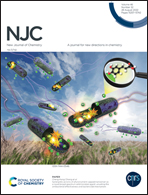A universal bipolar host based on isonicotinonitrile and carbazole for efficient red, green and blue PhOLEDs†
Abstract
Full colour display is vital to organic lighting-emitting diodes (OLEDs) and universal hosts for all red, green and blue (RGB) OLEDs are strongly desired. In this work, a universal bipolar host, namely BCz3PhCN, was synthesized by simply incorporating carbazole and isonicotinonitrile units. BCz3PhCN exhibits excellent thermal stability and a high triplet energy level (ET) of 2.76 eV; therefore, all RGB devices were fabricated to evaluate their electroluminescent (EL) performance. The blue device hosted by BCz3PhCN was lit at 3.0 V with the maximum external quantum efficiency (EQEmax) of 16.22%. Green PhOLEDs exhibited a better performance with the maximum luminance (Lmax) of 1 21 900 cd m−2, maximum current efficiency (ηc,max) of 69.30 cd A−1, maximum power efficiency (ηp,max) of 64.88 lm W−1 and EQEmax of 20.04%. Remarkably, the highest EQEmax of 26.84% was achieved by the red device in the low luminance range. The above excellent EL performance for all BCz3PhCN-based blue, green and red devices indicates a huge potential for BCz3PhCN as a universal host in developing high-performance monochrome and white OLEDs.



 Please wait while we load your content...
Please wait while we load your content...